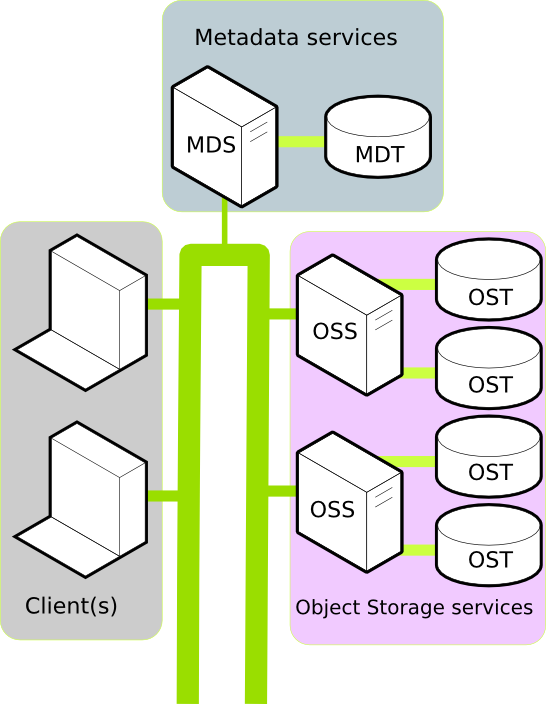Page History
Bird's eye view
A Lustre file system consists of a number of machines connected together and configured to service filesystem requests. The primary purpose of a file system is to allow a user to read, write, lock persistent data. Lustre file system provides this functionality and is designed to scale performance and size as controlled, routine fashion.
...
- One or more Clients.
- A Metadata service.
- One or more Object Storage services.
Client
A Client in the Lustre filesystem is a machine that requires data. This could be a computation, visualisation, or desktop node. Once mounted, a Client experiences the Lustre filesystem as if the filesystem were a local or NFS mount.
Further reading: LUSTRE MANUAL LINK
Metadata services
In the Lustre filesystem metadata requests are serviced by two components: the Metadata Server (MDS) an Metadata Target (MDT). Together, the MDS and MDT service requests like: Where is the file XYZ? I'm going to write to file ABC so prohibit anyone else from using it.
...
Further reading: LUSTRE MANUAL LINK
Object Storage services
Data in the Lustre filesystem is stored and retrieved by two components: the Object Storage Server (OSS) and the Object Storage Target (OST). Together, the OSS and OST provide the data to the Client.
...
Further reading: LUSTRE MANUAL LINK
Additional Services
Lustre includes additional services including LNET. LNET is designed to simplify configuration of a Lustre filesystem over complex network topologies.
Further reading: LUSTRE MANUAL LINK
Practical considerations.
Lustre currently has two actively developed and maintained branches. These the are 1.8.x and 2.1 releases. Lustre 1.8.x is used in production environments around the world. It is mature and stable. Lustre 2.1 introduces SMP scaling enhancements to exploit machines with large numbers of sockets, cores and threads. The Lustre 2.1 release is scheduled at the end of Q2, 2011.
...
If your environment is biased toward heavy write, or fast write operations, 16GB is recommenced per Object Storage Server (OSS). If reading is of primary concern, increasing OSS memroy to 48GB will enable significant read caching and greatly increase performance.
Further reading
A detailed discussion of Lustre design considerations can be found in the whitepaper LUSTRE WHITEPAPER DOWNLOAD http://wiki.whamcloud.com/download/attachments/425994/Lustre+OSS+and+MDS+server+node+Requirements+white+paper.docx![]()
...
